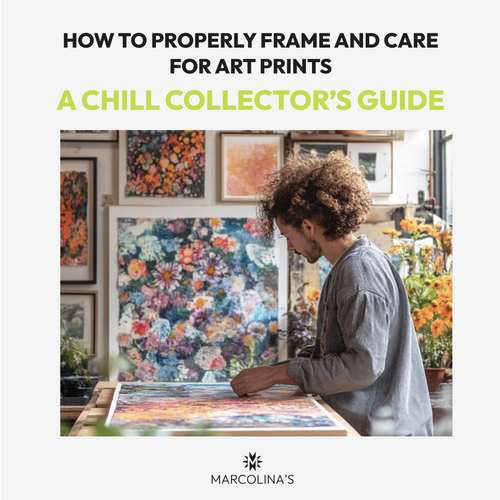So, you’ve just picked up an art print that makes your heart skip a beat. Maybe it’s that eye-catching abstract you found at a local fair or a limited-edition piece from your favorite art gallery. Whatever it is, your next move isn’t just to slap it on the wall and hope for the best. To keep that piece looking sharp for years (and make your space pop), you need to know how to frame and care for it like a pro. Don’t worry—this guide will make the process as smooth and stylish as your new artwork.
Frame Game: Picking the Right Style
Let’s be real—choosing a frame can feel like walking into a coffee shop and trying to pick between ten types of lattes. But it doesn’t have to be complicated.
- Frame Materials: Wood frames bring warmth and that timeless look, while metal frames lean modern and minimal. Both options are solid; just make sure they’re sturdy enough to last.
- Keep It Simple: A frame should highlight your art, not fight it for attention. Go for neutral tones like black, white, or a natural wood finish. If you’re feeling daring and the art calls for it, a pop of color can work, but tread lightly.
- Quality Counts: Cheap frames can warp or break, and that’s not the vibe you want for your prized print. Invest in something that’ll hold up and keep your art safe.
Matting: The Secret Sauce
Matting adds that extra bit of polish and, more importantly, keeps your print from pressing against the glass or acrylic (which could lead to damage down the line). It’s like the wingman of your frame—subtle but essential.
- Go Acid-Free: Always use archival-quality, acid-free mats. They’ll keep your art from yellowing or breaking down over time.
- Color Choices: White or off-white mats are classic for a reason—they look clean and complement most pieces. If your print has bold or unique colors, consider a mat that picks up one of those hues for a more dynamic look.
Glass or Acrylic? Decisions, Decisions
This is the part where a little extra thought goes a long way. Your art deserves to be protected, so choosing between glass and acrylic glazing is key.
- Glass: Traditional, reliable, and sturdy. Opt for non-glare or UV-protective glass to prevent your print from fading.
- Acrylic (Plexiglass): Lighter and shatter-resistant, which is perfect if you have a larger piece or if you’re clumsy (no judgment). Look for UV-filtering acrylic to keep the colors of your art vibrant.
- Quick Tip: UV protection is a must, no matter what you choose. Sunlight is great for plants, not so much for art.
Where to Hang Your Art (Hint: Not in Direct Sunlight)
The placement of your art can make or break its lifespan. Here’s how to find the perfect spot:
- Avoid the Sun: Even with UV protection, direct sunlight is like kryptonite for prints. Find a wall with indirect light, or add curtains or blinds if your favorite spot gets lots of sun.
- Temperature Matters: Skip the places that see wild temperature swings—like next to radiators or in bathrooms. Humidity and heat are silent art killers.
- Hang It Right: Aim for eye level when hanging your art. Typically, this means the center of the piece should be 57-60 inches from the floor. Trust us, it makes a difference.
Keeping It Fresh: Maintenance 101
You’ve framed it and hung it up—nice work! But caring for your art doesn’t stop there. Here’s how to keep it looking gallery-ready:
- Dusting: Use a soft microfiber cloth to dust the frame and glass/acrylic. No sprays or cleaning products needed—those can cause more harm than good.
- Handle with Care: If you need to move or adjust your art, hold it by the frame. Touching the print directly with your fingers is a no-go; oils and prints are not friends.
- Check Up Periodically: Every so often, take a closer look at your art. Tighten any loose hardware and keep an eye out for signs of fading or discoloration.
Storage Tips for Unframed Prints
Maybe you’ve got a few prints waiting for their big moment on the wall. Here’s how to store them safely in the meantime:
- Go Archival: Use acid-free storage materials—sleeves, folders, or even sturdy tubes.
- Flat vs. Rolled: If you can, store your prints flat to avoid bends and creases. If rolling is your only option, do it loosely and place them in a protective tube.
- Climate Control: Just like framed art, unframed prints should live in a cool, dry environment away from direct light.
Wrapping It Up: Framing and caring for your art prints is more than just a practical step—it’s part of creating an environment that celebrates what you love. A little extra effort goes a long way in preserving your art’s beauty and value. So, pick that perfect frame, hang your piece in just the right spot, and admire it every day knowing it’s protected and cherished. Because when it comes down to it, art should be enjoyed, not just owned.

